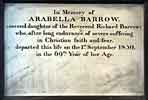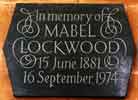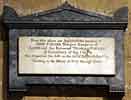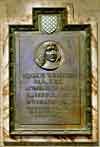For this church:    |
|
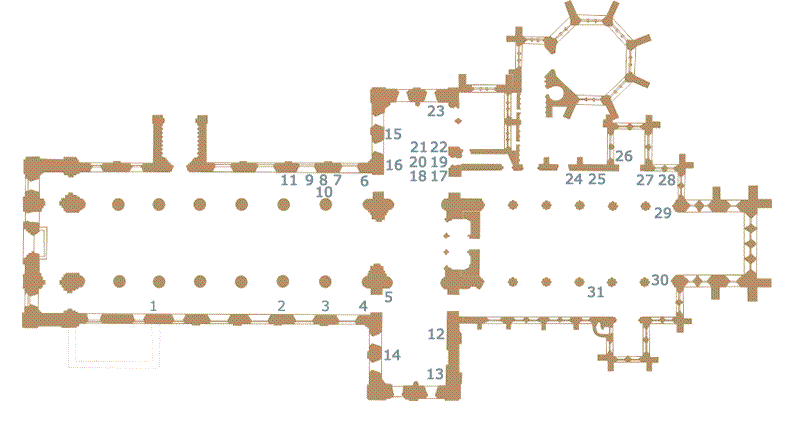
|
Key to Monuments |
Nave
1.William Samuel Sharpe (died 1858)
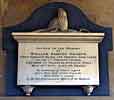
SACRED TO THE MEMORY MAY 12TH 1858, AGED 28 YEARS  For a dear and valued Comrade, This Tablet is erected By the Non-Commissioned Officers of his Regiment  |
2.Egbert Hacking (1854-1936)

| IN MEMORY OF EGBERT HACKING 1854-1936 THIS TABLET WAS ERECTED BY HIS CHILDREN TO RECORD A LIFE OF SERVICE TO THE CHURCH OF THIS DIOCESE FOR OVER 50 YEARS AS VICAR AND RECTOR OF EYAM, ST JAMES’S DERBY, CROMFORD AND CHESTERFIELD IN THE COUNTY OF DERBY AND OF HOLME PIERRPONT IN THE COUNTY OF NOTTINGHAM AND AS THE FIRST ARCHDEACON OF NEWARK |
3.William Wylde (died 1848)

This Tablet is erected |
4.Thomas Lewis Kekewich Edge (1860-1931)
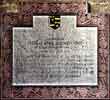
IN MEMORY OF |
End of south nave aisle, facing the crossing.
5.Frank Russell Barry, Bishop of Southwell (1941-1963)
FRANK |
The text is by Canon Bayes. The memorial was designed by Bryant Fedden and carved by Simon Verity. (Bryant Fedden was a pupil of Donald Potter, a longtime associate of Eric Gill).
North nave aisle, starting from the crossing:
6.William Barrow, Prebendary (died 1836) and his wife Elizabeth Ann (died 1823)
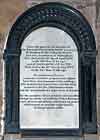
Near this place lie the Remains of |
7.Richard Barrow (died 1838) and his wife Mary (1801)
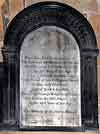
Near this place lie the remains of |
9.William Lawson, vicar of Kirkby Malzeard (died 1833) and his widow Mary Anne Lawson (died 1868)
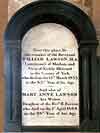
Near this place lie  And also of  |
10.Mabel Lockwood (1881-1974)
Underneath the memorial to Arabella Barrow.
The Christus Rex, by Peter Ball, suspended to the west of the crossing arch, was purchased largely by a sum of money given in memory of Mabel Lockwood by her son.
11.John Woolley (1823-1859) naturalist and zoologist

TO THE MEMORY OF |
South transept east wall
12.The Rev John Thomas Becher (died 1848) and his wife, Mary (died 1837)

IN  ALSO OF  THIS TABLET IS INSCRIBED  |
13.The Rev Henry Cook (died 1750)
Above the war memorial.

Near this place lies the Body of |
South transept west wall
14.Catherine Louisa Anson (died 1832)
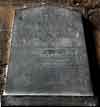
| To the Memory of CATHERINE LOUISA ANSON 3d daughter of THE REVD FREDK ANSON Prebendary of this Church Who died March 28th 1832 Aged 18   In manners gentle, in affection mild Who cannot doubt her happiness is fix’d Midst blissful joys, with earthly cares unmix’d Cut off so young – Her sins may God forgive She’s gone from earth, we trust in heaven to live, Parents rejoice! and sisters be ye glad Brothers in mourning, be no longer sad, All, combined the best you could have done Would not have earned the prize – Herself has won |
North transept west wall
16.Mary Porter (1830)

At a short distance from this Place are deposited the remains of |
North transept east wall
17.James John Trebeck (1837-1904)

TO THE |
The figure of The Good Shepherd is depicted in the centre and the coat of arms of the diocese and the crest of the Trebeck and Wordsworth families are shown in the border.
18.Francis Herbert Hume (died 1807)
Set on the wall above the Trebeck monument.
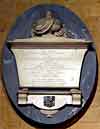
JUXTA SEPULTUS EST
In memorium dilecti conjugis |
19.Sir Edwyn Hoskyns (1851-1925)
 |
 |
 |
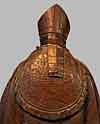 |
IN MEMORY OF
|
The bust is by W Reynolds Stephens and the wording was composed by the first Baron Charnwood.
The letter cutter is not known but the first E was initially omitted from WHOLESOME and had to be inserted later, rather neatly in the corner of the L.
To the right of the Hoskyns bust, located underneath the memorial to J J Trebeck, is this framed prayer:
| COLLECT FOR 19TH SUNDAY AFTER TRINITY O God, forasmuch as without thee we are not able to please thee; Mercifully grant, that thy Holy Spirit may in all things direct and rule our hearts; through Jesus Christ our Lord. Amen. |
Bishop Hoskyns, second Bishop of Southwell recommended the use of this prayer daily at noon; as a simple rule of life for those he was to confirm.
20.The Rev Benjamin Cooper (died 1741)
Set on the wall above the Hoskyns bust.

M: S. |
22.Thomas Cecil Smith Woolley (1853-1913)
Immediately below the Willoughby memorial tablet, there is a small tablet:
23.Edwin Sandys (died 1588)
 |
 |
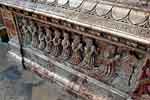 |
 |
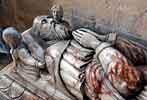 |
This alabaster memorial is to an Archbishop of York, Edwin Sandys, who lived out his later years as Archbishop here in Southwell. The carving on the front shows his family mourning his death in 1558. They kneel in order of gender, not of age. It has been assumed that it was carved by a Nottinghamshire carver from local alabaster, but recent studies have suggested that it may have been carved in York from deposits in that area. It is known to have been commissioned by the archbishop’s son, who would perhaps be more familiar with Yorkshire than with Nottinghamshire.
The inscription around the monument reads:
Edwinus Sandes sacrae theologiae doctor postquam vigornensem Episcopatum annos x totidemque tribus demptis Londinensem gessisset Eboracensis sui Archiepiscopatus ano xij vitae autem lxix obiit Julii x anno dom. 1588 |
Kilpeck (1839) translates this as: 'Edwin Sandys, D.D., after he had presided over the See of Worcester eleven [ten] years, and as many, save three, over that of London, died on the 10th of July, in the year of our Lord 1588, in the fifteenth [twelth] year of his Archbishoprick of York, and the sixty-ninth of his age; whose body lieth here interred.'
There is a lengthy Latin inscription on the west end of the memorial. Translated it reads:
The body of him who lies here was not of humble birth and lived with rank and in great state, but the example he set was greater: having filled two Bishoprics he was at length promoted to be Archbishop, having attained these honours at a high price with his virtues and deserts. He was a man above all men free from malice and vindictiveness, open and free of flattery, very liberal and compassionate, most hospitable, easy-going and proud, without it being a vice. He lived no less worthily than he taught others to do and devoted himself in preaching the gospel, being assiduous in this task to the end. No one could go away from listening to his sermons without being the better for them. He wished for eloquence and it was evident in him. Conscious of his own hard labours, he despised the idlers. He encouraged learning for the benefits it brought. He upheld Church possessions as anything dedicated to God deserved to be. By your favour with Elisabeth, the most illustrious of mortals, oh venerable man you were able to save this Church in which you yourself lie, from despoil. You were a notable example of the chances of life who, however much you had to bear, endured all ills great and many with imperturbable spirit – prison, exile, loss of much good fortune and above all the hardest thing for an innocent mind to bear, most malicious slanders: and in one thing alone was your wish unfulfilled - the shedding of your own blood in support of your belief in Christ. And now after such fluctuation in prosperity and so many contests against hostility, being tired of life you have at length achieved the goal of perpetual rest in your search for God, rejoice evermore your toils are acceptable to God instead of your blood being shed. Go reader do not think it enough to know these things but copy them. The word of the Lord abideth forever. |
Choir north aisle
25.Unknown priest / The Rev John Phillips (died 1742)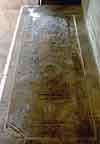
On the floor to the east of the vergers’ vestry. A large memorial stone which, until 2013, was to be found forming part of the flooring of the north porch. When a scheme to level and improve the north entrance was carried out in early 2013, this stone was removed and transferred to its new position.
It would appear that this stone had formed part of the floor of the north porch for several centuries and it had been the subject of considerable interest and speculation. An article in the Transactions of the Thoroton Society (1929) provides the following insight:
'The inscription has now been read and translated. The date is 1536 and the stone commemorates a priest. The inscription is in Latin hexameters and pentameters.
'Spiritus archipotens subhumati flaminus , imo (Tau)
Dum vivit facinus ussit et alta : tuo (Tau)
Numine confiteare fleas; tum culmina celi (Tau)
E mundo latus redde rogamus ei'
Translation:
“O all powerful spirit, the crime of the priest buried here, verily blazed up to the very utmost while he lived. Mayest thou confess to the Divinity, mayest thou weep. Then we pray, mayest thou restore to him the summits of heaven, having taken him out of the world”
In the middle of the stone is carved a heart and round it are more words in Latin which are so badly worn that deciphering is most difficult. The suggested interpretation of this part of the inscription is
“Vile thing are in my heart and flesh. I am very low. Begone (i.e. do not stay near one so base)”
The appearance of the Greek letter 'Tau' at the end of each line of the epitaph is probably accounted for by the fact that at one time this letter was the last in the Greek Alphabet and was used to mark the end of anything.
In 1742 this tombstone was re-used to commemorate 'The Revd Mr Phillipps'. John Phillips B.A. (deacon) was admitted Vicar Choral, 17 November 1737 and his office was filled on 5 April 1744, after his death. The stone says that he died 16 October 1742 so that he was quite a young man. It is curious that the chapter should have allowed such a large and important stone to be spoilt to preserve the memory of this youth of only 5 years' service.
It would be very interesting to know what had been the crime of the priest which merited such an epitaph. In the absence of any information it is perhaps allowable to suggest that as the year 1536 was one when Henry VIII was in the thick of his quarrel with the Pope, this unnamed priest had been on the wrong side and that those who wrote his epitaph certified their own loyalty in this way.
The re-siting of this stone does not help to solve the mystery and so the puzzle remains.'
26.Robert Frederick Smith (1833-1905)
Between the two windows west of St Thomas Chapel.

TO THE GLORY OF GOD  BLESSED ARE THEY WHO DWELL IN THY HOUSE |
27.William Talbot, a canon of the late fifteenth century
Plaque on the north wall of the Airmen’s Chapel.

| Hic iacet Will[el]m[u]s Talbot miser et i[n]dignus Sacerdos expectans resurrect[i]o[n]em mortuor[um] sub signo thau |
The translation of the Latin is
Here lies William Talbot wretched
and unworthy priest awaiting
the resurrection of the dead under the sign of the tau
28.The Katyn Memorial
Next to the Talbot memorial.
It was carved by Beauford Linley to the design and lettering prepared by Ronald Sims.
29.RAF Memorial Plaque
Leaning against the pillar to the south of the altar is a metal plaque, originally intended to be wall-mounted. It reads:

| IN PROUD MEMORY OF THE OFFICERS WARRANT OFFICERS & AIRMEN OF No. 12 GROUP FIGHTER COMMAND ROYAL AIR FORCE WHO GAVE THEIR LIVES IN THE AIR DEFENCE OF THIS COUNTRY DURING THE YEARS OF THE WORLD WAR 1939-1945 THIS ENSIGN WAS GIVEN AS A SYMBOL OF THEIR COMRADES’ DETERMINATION TO UPHOLD THE GREAT PRINCIPLES OF FREEDOM AND JUSTICE FOR WHICH THEIR SACRIFICE WAS MADE “And in that faith they died” |
The ensign referred to is the RAF ensign mounted alongside the flag of Poland on the north wall of the chapel.
Between the chancel and St Oswald's Chapel
30.George Ridding, first Bishop of Southwell
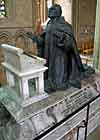 |
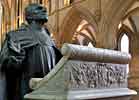 |
 |
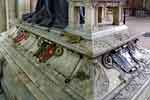 |
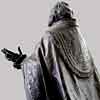 |
The plinth and the reading desk are by W D Caroe and the bronze is by F W Pomeroy (1856-1924). (The cope depicted on the bronze has been in continuous use by subsequent Bishops of the Diocese).
| GEORGE RIDDING D.D. RVLER: SCHOLAR: DIVINE 43RD HEADMASTER OF WINCHESTER COLLEGE 1866 - 1884 FIRST BISHOP OF SOVTHWELL 1884-1904 “THEY WILL GO FROM STRENGTH TO STRENGTH” |
Inscribed on the open book on the reading desk are the words
| LORD OVR HEAR PRAYER |
South choir
31.Unknown priest
 |
 |
Badly damaged, headless effigy of a priest, probably an archbishop, of the mid-15th century. The most likely candidate from this period is William Booth who is known to have been buried at Southwell.
Floor slabs
Nave and nave aisles
| John the Son of the Revd [...] John Barnard died November the 13th 1722 In the 3d year of his Age |
The Rev John Barnard was a Vicar Choral at Southwell – appointed Oct 1717, died 24 Oct 1728.
| Here lies a Blossom dropt from Human Race Whose Soul is Fled too Blest Immortal Place His body too when once Repair’d shall shine In Glories ever Fresh ever Divine William Brailsford Aged 19 1707 |
| The Revd John H[?olmes] M.A. Twenty four Years Vicar Choral Of this Collegiate Church Died Sepr 20th 1784 Aged 57. |
| ELIZABETH Widow of WILLIAM SWYMMER Esqr of Rowbarrow in the County of Somerset: died 2nd of January 18[0]6 Aged 87 Years. |
BRIDGET |
| Hic jacet Wills : Smith qui obijt xviij die mens octob ao Dm: Millmo cccc xxxij |
| Here lieth the body of Mr William Tyrell who was buried Feb: ye 19th 1724 In the 59th year of his age |
| GVILIELMV[… ... …]IVS GVIL IELMI THO[… … …]ON ET MIL LICENTIAE [… …. …] XORISPRO BAE INDOLI[… … …] GENIIPVER ETHVIVS E[… … …]IAE CHO RISTA AN[… … …] AGEVIS SVAE AETAT[… … …]ECIMVM QVART VI[… … …]ECIMVM SIT PRIMO[… … …] |
| Interred the Body of Elizabeth Wildon Niece to Mr Wilson and Mr Clay Died October 6th 1793 Aged 73 Years |
| Interred the Body of Elizabeth Wilson Relic of the Revd Edward Wilson late Prebendary of this Collegiate and Rector of Teversal Died Nov 9th 1778 Aged 81 Years |
Edward Wilson was Vicar General of the Minster in 1749 and Prebendary of Beckingham 1727 – 1753; rector of Teversall 1716-45. Died 1753.
| ARABELLA BARROW BORN 12 MARCH 1784 DIED 1 SEPTEMBER 1830. |
| [ELIZ]ABETH ANN [TH]E WIFE [OF] THE REV. D. W[…] DIED JULY 21 1[…] AGED 75 |
| MARY the Wife of the RevD RICHARD BARROW, born April 26th 1733, died August 30th 1801. |
| The Reverend RICHARD BARROW B D born September 22nd 1747, died February 2? 1838. |
| THE REVEREND WILLIAM BARROW, D. C. L DIED APRIL 19TH 1836 AGED 81. |
| MRS SUTTON BULLE[N] DIED MAY 3D 1832 AGED 62.  ELIZABETH HODGKINSON ANOTHER DAUGHTER OF THE [?LATE] GEORGE HODGKINSON DIED FEBRUARY 22 [1835] AGED 74. |
| Diana the daughter of Sam Lowe EsqrS died 24 May 1712 |
| HERE LYETH THE BODY OF CASS ANDRA CHAPPELL LATE THE WIFE OF HENRY CHAPPELL [?]ENT WHO DEPA[RT] [E]D THIS LIFE THE 7TH OF APRILL 1668 |
| Catherina Ellis died May 27 1725 Aged 7 weeks |
| Elizabeth Relict of John Marshal[l] Born 25th Novr 1726 Died 13th feb 1808 |
| Here Lieth the Body of Mary the Wife of Gervas Marshall who died Ian the 7 1735 Aged 61 Years. |
There is a brass plaque to Gervase Marshall who died in 1776 in the centre of the slab.
| SACRED to the Memory of KITTY COWART CANE the Widow of the Revd ROBERT CANE, who died on the 16th of Sepr 1802 AGED 38 YEARS. |
| SACRED to the Memory of the Revd ROBERT CANE late Vicar Choral of this Church who died on the 6th of January 1802 AGED 47 YEARS. |
| Here Lieth the Body of Mr Edmund Crofts who Departed this Life October the 29 1727 Aged 58 |
North transept
In Memory |
IN MEMORY OF |
HERE |
South transept
Rich Hutchinson |
Choir aisles
+ |
In |
Thank |
Thank |
WELL DONE GOOD AND FAITHFUL SERVANT |
Kenneth |
+ Remember |
Brass plaques
There are a number of brass plaques set into the floor throughout the church.
Nave and nave aisles
ELIZA WALKER, |
Mary Foottit |
Geo. Hodgkinson Esqr |
| Mary the Wife of Geo. Hodgkinson Esqr. Died Febry 19th 1791, in the 63d Year of her Age. |
North transept
HERE lieth Interred |
HERE |
HERE |
South transept
GILBERT |
BERTIE PELHAM, |
Catherine Charlotte Clay |
Benjamin Clay Esqre  Elizabeth his wife |
ELIZA MARIA CLAY, |
W:W PELHAM CLAY, |
JEM[IMA] EVELYN |
| JEMIMA CLAY the Wife of William Clay, Died Febry 22d 1813 Aged 79 Years. |
Lieut Genl W. W. Pelham Clay |
In |
WILLIAM CLAY |
MARIA LEEK FRANCISCI |
Subtus Quiescit |
Mary Clay Twigg Hutchinson |
Nicholas Hutchinson,  Elizabeth wife of Nicholas Hutchinson  N & E Hutchinson. |
Exuvia CAROLI LEEK de |
| Franc: Leek PREBEND: DE WOODBROW SEPULTUS 17 DIE DECEMB: 1670 INTER MARIAM FLOWER VIDUAM PRIOREM VXOREM AD SINISTRAM et Margaretam Leek SECUNDAM AD DEXTRAM; RESURGEMUS |
WALDEGRAVE PELHAM ESQR |
| CHARLOTTE SPENCER Daughter of W. Waldegrave Pelm Clay and Cathe Chartte his Wife, Died Decr 14th 1803, Aged 11 WEEKS. |
Medieval Cross Slabs
See Archaeology section.



